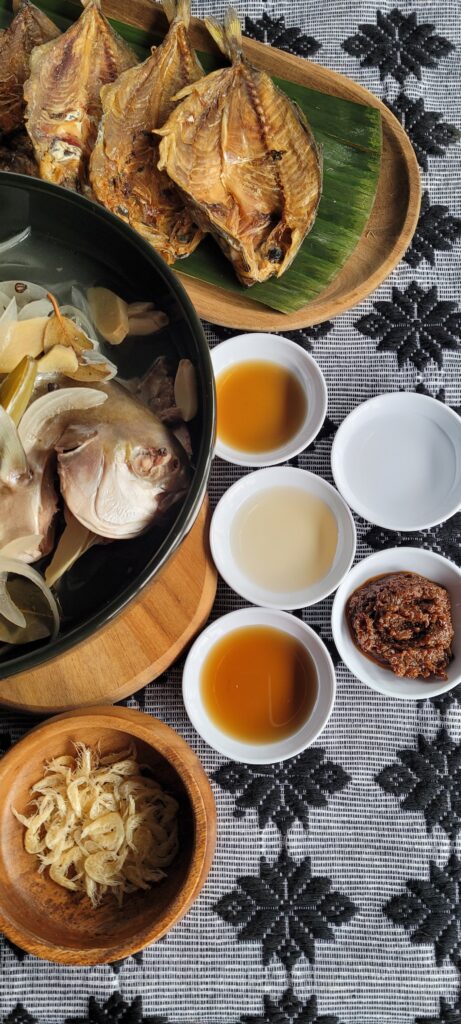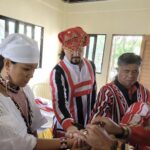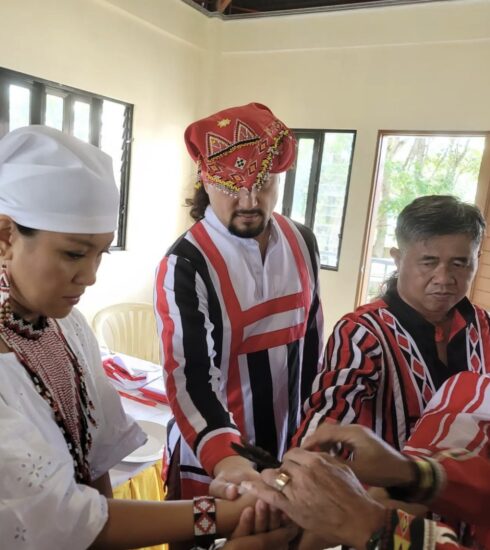From Vinegar to Paksiw: A Look at Pre-colonial Philippine Food Preservation

As long as humans have existed, cultures across the world have preserved and processed their food in one way or another. For indigenous Filipinos, this was no different. Whether as a means to ensure there was enough to eat during seasons when supplies were low, to have a meal during travel, or to make an essential cooking ingredient, food preservation in the precolonial Philippines helped play a major role in developing some of the signature flavors of our cuisine.
While it’s easy to associate the term “pre-colonial” with something that is no longer being practiced, these methods haven’t disappeared completely. Although the procedures may have evolved, preserved foods have helped lay the foundation for many of the most beloved Filipino dishes; from the vinegars that flavor our lola’s signature adobo to the tinapa (smoked fish), our parents served with rice and eggs.
Fermentation
The word fermentation often invokes images of alcohol or pickles (like atchara). While both of these were made prior to the Spanish landing on our islands and are still part of the Filipino culinary landscape today, it would be doing a great disservice to not mention one of the most essential Philippine ingredients: vinegar. Antonio Pigefetta, a historian who arrived with Magellan’s crew, recorded coconut vinegar as one of the first food items he encountered when he arrived in 1521.
Vinegar, or suká, was extremely important to the pre-colonial Filipinos. In addition to being used for cooking and food preservation, vinegar was also believed to cure a variety of physical ailments, including fevers and headaches. To make vinegar, one could use a variety of natural ingredients; some of the most popular include: nipa palm sap, coconut flower sap, and sugarcane. There was no primary vinegar type that was used throughout the entire archipelago, as this depended on what natural resources were available where it was being made. To make vinegar, the natural liquid of choice was gathered and stored in earthen-ware clay jars called tapayan. Sometimes, this would require cooking the liquid. The jarred liquid would then be exposed to the sun. Within a week, it would turn into vinegar and ready to use. While today’s modern world relies more on mass produced vinegars, there are still a small number of artisans today who make their vinegars according to the traditional methods passed down through the generations.
Aside from vinegars, our ancestors also made alcohol. Commonly called alak, tapuy, or tuba; these libations were also made from saps, nectars and other fermentable ingredients. Oftentimes, vinegar happened to be a by-product of this alcohol-making. For example, in the Illocos region they make their indigenous alcohols and vinegars from the abundance of sugarcane in the region. The sugarcane juice is extracted, boiled down and fermented in tapayan to make the fermented wine called basi. Sukang Illoco vinegar can be made by further allowing the basi to ferment past its required fermentation period.
For those with access to the various bodies of water, seafood was fermented to make beloved condiments. Similar to surrounding Asian countries, Filipinos fermented tiny fish in tapayan to make patis (fish sauce). Bagoong (a fermented seafood paste) was also made through salting and fermenting small fish or shrimp. In the Visayas and Mindanao, dayok was made according to a process similar to that of bagoong; a key difference being that fish entrails were used as the primary ingredient, rather than the whole fish. The result of all three fermentations is a wonderfully salty condiment and seasoning agent. Today, though despite being produced industrially, these products are still enjoyed by Filipinos both at home in the motherland and spread throughout the diaspora.
Salting, Drying, and Smoking
While it’s no longer necessary for us to hunt and fish as our ancestors did, it doesn’t mean that dried foods aren’t enjoyed any less. Similar to the bacon and jerky that we enjoy today, early Filipinos also smoked, dried and salted their proteins to preserve them for extended use. It is unknown if Pigefetta was able to witness any specific methods of salting, drying, or smoking food, as he didn’t record any of these observations.
As an island nation, it’s impossible to think of dried or smoked food without thinking of seafood. Walk into a Filipino market or restaurant and find at least one dish with a component prepared in this way. According to Filipino food writer and historian Doreen G. Fernandez, fish was salted and dried in times of abundance, in order to prepare for times of scarcity. This was such a common practice for those who had access to the ocean and rivers that there were specific terms for the methods of drying, salting and smoking.
If you were looking to prepare fish in the daing method, a large fish would be split open and butterflied from the back. This fish would be dried in the sun for later use (often to be roasted as is or used to flavor vegetable dishes). Tuyo referred to smaller fish prepared in this manner; tuyo is still enjoyed today as a popular accompaniment for champorado (chocolate rice porridge) and as a snack. Tinapa was the term for any size of fish that was smoked until its skin turned golden brown. Balbakwa (in Tagalog) referred to small fish that were layered in rock salt and allowed to dehydrate in containers; these were often saved to cook in vinegar or as a flavoring agent for other dishes. Fish wasn’t the only water-based protein that was preserved either. Shrimp was an abundant resource around the coastal areas of the archipelago. The Illongo would salt and dry tiny shrimp into kalkag. Larger shrimp prepared in this manner (after being peeled) was called hibe.
Communities with limited access to fishing waterways also dried their land-based proteins after hunting. This method, called tapa, usually invokes our modern mental images of beef. However, in the precolonial Philippines, their tapa usually consisted of deer or wild boar. According to Fernandez, the meat used for tapa was never sold for profit. Instead, it was shared amongst members of the hunter’s community.

Cooking with Vinegar
This one probably shouldn’t come as much of a surprise, due to the fact that Philippine adobo has often been hailed as one of the dishes that has survived from pre-colonial times. To reference previous parts of this article, vinegar has long been used for purposes other than fermenting. In “Tikim: Essays on Philippine Food and Culture” by Doreen G. Fernandez, there is a theory by Raymond Solokov that states that Philippine adobo was named because Spanish explorers thought the cooking method was similar to their “adobado” method, which was meat being stewed in wine and onions. Pigefetta recorded “adobado” as “meats marinated in vinegar to avoid them from spoiling quickly.”
On all accounts, there is a nugget of truth in this. Pre-colonial Filipinos didn’t have refrigeration or widely-used methods of cooling foods to avoid spoilage. Cooking and marinating items in vinegar and other souring agents, such as sampalok (tamarind) or kamias (sour member of the starfruit family), served as a way to extend the longevity of these proteins, as well as a way to preserve food for travel. There are quite a few of these methods, used both for seafood and animals hunted from the land. It is believed that these long-used cooking methods are one of the many reasons why the Filipino flavor palate has a love for sourness.
Beyond adobo, another method is that of paksiw. Foods cooked for paksiw (traditionally fish) were cooked in vinegar and could be served either hot or cold. In modern cuisine, leftover lechon (suckling pig) is often cooked paksiw-style as a way to transform an ingredient for use in another dish. The Illongo people also use a method called pinamalhan. When cooking something pinamalhan, the food is cooked until all the liquid (including the vinegar) is cooked away. This comes from the word “mala,” which means “dry.”
Finally, there is the lamayo method, which is also popularly used for fish. This “wet” preservation method (a marination step) is commonly used for dishes like daing na bangus. For dishes that use the lamayo method, the fish or other desired seafood is marinated in garlic, spices, and vinegar (or other souring agent). The acid partially cooks the seafood, helping it last a bit longer before the protein is cooked or dried.
The food preservation methods detailed above are only a sampling of the ones used by our ancestors, but it is apparent how they still greatly influence Philippine cooking today. Mass production may have helped bring these methods into the modern age, but our culture will always have the blueprint. Despite the passage of time and foreign influence, these techniques and the iconic dishes they produce remain undeniably Filipino.
Sources:
Tikim: Essays on Philippine Food and Culture. By Doreen G. Fernandez, published in 1994.
Palayok: Philippine Food Through Time, On Site, In the Pot. By Doreen G. Fernandez. Published in 2000
Pigefetta’s Philippine Picnic: Culinary Encounters During the First Circumnavigation, 1519 – 1522. Retold by Felice Prudente Sta. Maria, Published in 2021
Lactic Acid Bacteria in Philippine Traditional Fermented Foods. By Charina Gracia B. Banaay, Marilen P. Balolong and Francisco B. Elegado. Accessed on May 5, 2023.
Culture Ingested: The Indigenization of Philippine Food. By Barbara Kirshenblatt-Gimblett and Doreen G. Fernandez. Accessed on May May 7, 2023.
Taste Atlas: Lamayo
Accessed on May 7, 2023
Processed Food: A 2-Million Year-History. By Evelyn Kim. Published September 1, 2013 in Scientific American. Accessed on May 22, 2023.
History of Food Preservation Timeline – When Did People Start to Preserve Food? By Eric Mitchell. Updated April 29, 2023. Accessed on May 22, 2023.






